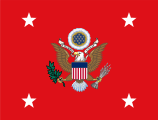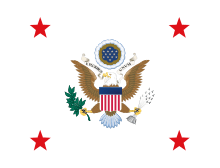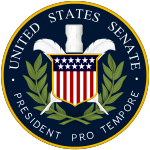William H. Crawford
| William Crawford | |
|---|---|
 | |
| 7th United States Secretary of the Treasury | |
|
In office October 22, 1816 – March 6, 1825 | |
| President |
James Madison James Monroe |
| Preceded by | Alexander Dallas |
| Succeeded by | Richard Rush |
| 9th United States Secretary of War | |
|
In office August 1, 1815 – October 22, 1816 | |
| President | James Madison |
| Preceded by | James Monroe |
| Succeeded by | John Calhoun |
| United States Minister to France | |
|
In office March 23, 1813 – August 1, 1815 | |
| President | James Madison |
| Preceded by | Joel Barlow |
| Succeeded by | Albert Gallatin |
| 25th President pro tempore of the U.S. Senate | |
|
In office March 24, 1812 – March 23, 1813 | |
| Preceded by | John Pope |
| Succeeded by | Joseph Varnum |
| United States Senator from Georgia | |
|
In office November 7, 1807 – March 23, 1813 | |
| Preceded by | George Jones |
| Succeeded by | William Bulloch |
| Personal details | |
| Born |
William Harris Crawford February 24, 1772 Amherst County, Virginia, British America |
| Died |
September 15, 1834 (aged 62) Crawford, Georgia, U.S. |
| Political party |
Democratic-Republican (1803–1828) Democratic (1828–1834) |
| Spouse(s) | Susanna Gerardine |
| Children | 7 |
.jpg)
William Harris Crawford (February 24, 1772 – September 15, 1834) was an American politician and judge during the early 19th century. He served as United States Secretary of War from 1815 to 1816 and United States Secretary of the Treasury from 1816 to 1825, and was a candidate for President of the United States in 1824.
Early life
Crawford was born on February 24, 1772 in the portion of Amherst County, Virginia that later became Nelson County, the son of Joel Crawford and Fanny Harris. He moved with his family to Edgefield County, South Carolina in 1779, and to Columbia County, Georgia in 1783. Crawford was educated at private schools in Georgia and at Richmond Academy in Augusta. After his father's death, Crawford became the family's main financial provider, and he worked on the Crawford family farm and taught school. He later studied law, was admitted to the bar in 1799, and began to practice in Lexington. Also in 1799, Crawford was appointed by the state legislature to prepare a digest of Georgia's statutes.
Political career
William H. Crawford influenced Georgia politics for decades.[1] In 1803, Crawford was elected to the Georgia House of Representatives as a member of the Democratic-Republican Party, and he served until 1807. He allied himself with senator James Jackson. Their enemies were the Clarkites, led by John Clark. In 1802, he shot and killed Peter Lawrence Van Alen, a Clark ally, in a duel. Four years later on December 16, 1806, Crawford faced Clark himself in a duel, resulting in Crawford's left wrist being shattered by a shot from Clark, but he eventually recovered.[2] In 1807, Crawford joined the 10th United States Congress mid-term as the junior U.S. Senator from Georgia when the Georgia legislature elected him to replace George Jones, an appointee who had held the office for a few months after the death of Abraham Baldwin.
Crawford was elected President pro tempore in 1811. When Vice President George Clinton died on April 20, 1812, Crawford, as President pro tempore, became the first "Acting Vice President" until March 4, 1813.
In 1811, Crawford declined to serve as Secretary of War in the Madison administration. In the Senate, he voted for several acts leading up to the War of 1812, and he supported the United States' entry into the war, but was ready for peace.[3] Crawford said, "Let it then be the wisdom of this nation to remain at peace, as long as peace is within its option."[4]
In 1813, President James Madison appointed Crawford as the U.S. minister to France during the waning years of the First French Empire; Crawford held that ministerial post until 1815, shortly after the end of the War of 1812.[5]
Upon Crawford's return, Madison appointed him as Secretary of War. After slightly more than a year of satisfactory service in that post (and after disclaiming interest in the 1816 Democratic-Republican nomination for President), Crawford moved within the Cabinet to become Secretary of the Treasury. He remained in that position through the rest of Madison's term and Monroe's entire administration, which ended in 1825.
Crawford was again a leading candidate for the Democratic-Republican presidential nomination in 1824. However, Crawford was put out of the running because of a paralytic stroke he suffered in 1823 that was brought on by a prescription given to him by his physician.[6] The Democratic-Republican Party split around this time and one of the splinter groups nominated Crawford.
Despite Crawford's improved health (and the support of former presidents Madison and Jefferson), he finished third in the electoral vote, behind New Orleans war hero Andrew Jackson and Secretary of State John Quincy Adams. He thus was still in the nominal running when the Presidential election ended up in the House of Representatives, due to the provision within the Twelfth Amendment giving a line on the House ballot to each of the top three candidates, but his stroke made him a non-factor there.
Refusing Adams's request that he remain at the Treasury, Crawford then returned to Georgia, where he was appointed as a state superior court judge. Crawford remained an active judge until his death a decade later.
Crawford was nominated for vice president by the Georgia legislature in 1828 but later withdrew after support from other states was not forthcoming. Crawford also considered running for vice president in 1832 but decided against it in favor of Martin Van Buren. Crawford also considered running for president again in 1832 but dropped the idea when Andrew Jackson decided to seek a second term.
Societies
During the 1820s, Crawford was a member of the prestigious society Columbian Institute for the Promotion of Arts and Sciences, who counted among their members former presidents Andrew Jackson and John Quincy Adams.[7] Crawford also served as a Vice President in the American Colonization Society from its formation in 1817 until his death.
Personal life
Crawford was descended from John Crawford (1600–1676), who had come to Virginia in 1643; John Crawford died taking part in Bacon’s Rebellion. John’s son David Crawford, I (1625–1698) was the father of David Crawford, II (1662–1762) and the grandfather of David Crawford, III (1697–1766). David Crawford, III married Ann Anderson in 1727 and had 13 children, including Joel Crawford (1736–1788).
His cousin George W. Crawford served as Secretary of War under President Zachary Taylor.
Crawford is buried at the site of his home, about one-half mile west of the current Crawford city limit.
Legacy
-%240.50-Fr.1381.jpg)
In 1875, Crawford appeared on the 50 cent bill.
The following are named in honor of William H. Crawford.[8]
Cities and towns
Counties
- Crawford County, Arkansas
- Crawford County, Georgia
- Crawford County, Illinois
- Crawford County, Indiana
- Crawford County, Iowa
- Crawford County, Michigan
- Crawford County, Missouri
- Crawford County, Wisconsin
Notes
- Garraty, John A. and Mark C. Carnes. American National Biography, vol. 5, "Crawford, William Harris". New York : Oxford University Press, 1999.
- Mooney, Chase C. William H. Crawford, 1772-1834. Lexington, KY : University Press of Kentucky, 1974
- Shipp, J.E.D. Giant Days or The Life and Times of William H. Crawford. Americus, GA : Southern Printers, 1909
References
- ↑ Fair, John D. (2015). "Governor David B. Mitchell and the 'Black Birds' Slave Smuggling Scandal". Georgia Historical Quarterly. 99 (4). Retrieved 24 October 2016.
- ↑ Long, Kim. "The Almanac of Political Corruption, Scandals & Dirty Politics, (2008). ISBN 0307481344.
- ↑ Green, Philip J. (1942). "William H. Crawford and the War of 1812". The Georgia Historical Quarterly. 26 (1): 21. JSTOR 40576819.
- ↑ Gales, Joseph (1853). The Debates and Proceedings in the Congress of the United States, Eleventh Congress, First and Second Sessions [volume 1]. Washington, D.C.: Gales and Seaton. p. 543. Retrieved 24 October 2016.
- ↑ Kaplan, Lawrence S. (1976). "The Paris Mission of William Harris Crawford, 1813-1815". The Georgia Historical Quarterly. 60 (1): 9. JSTOR 40580240.
- ↑ They Also Ran, Irving Stone, pg. 36
- ↑ Rathbun, Richard. The Columbian institute for the promotion of arts and sciences: A Washington Society of 1816-1838. Bulletin of the United States National Museum, October 18, 1917. Retrieved 2010-06-20.
- ↑ Gannett, Henry (1905). The Origin of Certain Place Names in the United States. Govt. Print. Off. p. 95.
External links
- United States Congress. "William H. Crawford (id: C000895)". Biographical Directory of the United States Congress.
- William Harris Crawford Collection from the Georgia Historical Society
- Troup-Clarke Political Feud historical marker
| United States Senate | ||
|---|---|---|
| Preceded by George Jones |
U.S. Senator (Class 2) from Georgia 1807–1813 Served alongside: John Milledge, Charles Tait |
Succeeded by William Bulloch |
| Political offices | ||
| Preceded by John Pope |
President pro tempore of the U.S. Senate 1812–1813 |
Succeeded by Joseph Varnum |
| Preceded by James Monroe |
United States Secretary of War 1815–1816 |
Succeeded by John Calhoun |
| Preceded by Alexander Dallas |
United States Secretary of the Treasury 1816–1825 |
Succeeded by Richard Rush |
| Diplomatic posts | ||
| Preceded by Joel Barlow |
United States Minister to France 1813–1815 |
Succeeded by Albert Gallatin |
| Party political offices | ||
| Preceded by James Monroe |
Democratic-Republican nominee for President of the United States¹ 1824 Served alongside: John Quincy Adams, Henry Clay, Andrew Jackson |
Party abolished |
| Notes and references | ||
| 1. The Democratic-Republican Party split in the 1824 election, fielding four separate candidates. | ||




